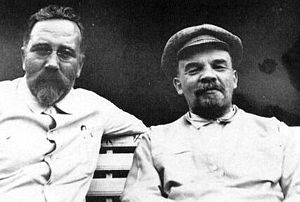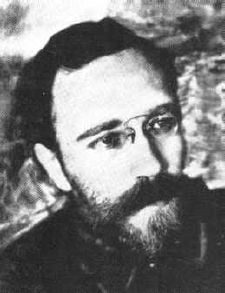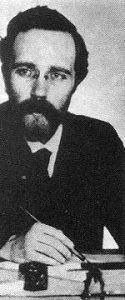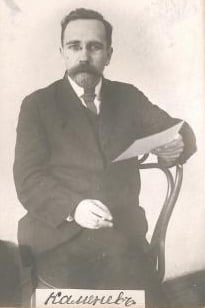Lev Kamenev
 From Nwe
From Nwe
|
|
|
| Term of office | November, 1917 – November, 1917 |
| Preceded by | Alexander Kerensky Head of State as a President of the Russian Provisional Government |
| Succeeded by | Yakov Sverdlov |
| Date of birth | July 18, 1883 |
| Place of birth | Moscow, then Russian Empire, now Russian Federation |
| Date of death | August 25, 1936 |
| Place of death | Moscow, then Soviet Union, now Russian Federation |
| Spouse | Olga Kameneva |
| Political party | Bolshevik |
Lev Borisovich Kamenev ▶ (Russian: Лев Борисович Каменев, born Rosenfeld, Розенфельд) (July 18 [O.S. July 6] 1883 – August 25, 1936) was a Bolshevik revolutionary and a prominent Soviet politician. He was briefly the nominal head of the Soviet state in 1917 and a founding member (1919) and later chairman (1923-1924) of the ruling Politburo.
The Bolsheviks were a faction of the Marxist Russian Social Democratic Labor Party (RSDLP) which split apart from the Menshevik faction[1] at the Second Party Congress in 1903 and ultimately became the Communist Party of the Soviet Union.[2] The Bolsheviks seized power in Russia during the October Revolution phase of the Russian Revolution of 1917, and founded the Soviet Union. Bolsheviks (or "the Majority") were an organization of professional revolutionaries under a strict internal hierarchy governed by the principle of democratic centralism and quasi-military discipline, who considered themselves as a vanguard of the revolutionary proletariat. Their beliefs and practices were often referred to as Bolshevism.[3] Kamenev, like many of this colleagues, would ultimately perish during the Great Purges, a victim of Stalin's manipulation of the Party to secure his own power.
Background
Kamenev was born in Moscow, the son of a Jewish railway worker and a Russian Orthodox housewife. [4] He joined the Russian Social Democratic Labor Party (RSDLP) in 1901 and its Bolshevik faction when the party split into Bolsheviks and Mensheviks in August 1903. [5] He went to school in Tiflis, Georgia (now Tbilisi) and attended Moscow University, but his education was interrupted by an arrest in 1902. From that point on, he was a professional revolutionary, working in Saint Petersburg, Moscow and Tiflis. Kamenev married a fellow-Marxist (and Leon Trotsky's sister), Olga Kameneva, nee Bronstein, in the early 1900s and the couple had two sons, both of whom were executed by the Soviet government in 1928 and 1929.
A brief trip abroad in 1902 introduced Kamenev to the Russian social democratic leaders living in exile, including Vladimir Ilyich Ulyanov Lenin, whose adherent and close associate he became. He also visited Paris and met the Искра (Iskra or The Spark–Lenin's revolutionary newspaper) group. After attending the 3rd RSDLP Party Congress in London in March 1905, Kamenev went back to Russia to participate in the Russian Revolution of 1905 in Saint Petersburg in October-December. He went back to London to attend the 5th RSDLP Party Congress, where he was elected to the party's Central Committee and the Bolshevik Center, in May 1907, but was arrested upon his return to Russia. Kamenev was released from prison in 1908 and the Kamenevs went abroad later in the year to help Lenin edit the Bolshevik magazine Proletariy (The Proletariat. After Lenin's split with another senior Bolshevik leader, Alexander Bogdanov, in mid-1908, Kamenev and Grigory Zinoviev became Lenin's main assistants abroad. They helped him expel Bogdanov and his Otzovist (Recallist) followers from the Bolshevik faction of the RSDLP in mid-1909.
In January 1910, Leninists, followers of Bogdanov and various Menshevik factions held a meeting of the party's Central Committee in Paris and tried to re-unite the party. Kamenev and Zinoviev were dubious about the idea, but were willing to give it a try under pressure from "conciliator" Bolsheviks like Victor Nogin. Lenin was adamantly opposed to any re-unification, but was outvoted within the Bolshevik leadership. The meeting reached a tentative agreement and one of its provisions made Trotsky's Vienna-based Pravda a party-financed "central organ." Kamenev, Trotsky's brother-in-law, was added to the editorial board from the Bolsheviks, but the unification attempts failed in August 1910 when Kamenev resigned from the board amid mutual recriminations.
After the failure of the reunification attempt, Kamenev continued working in Proletariy and taught at the Bolshevik party school at Longjumeau near Paris [6] that was created as a Leninist alternative to Bogdanov's Capri-based party school. In January 1912, Kamenev helped Lenin and Zinoviev to convince the Prague Conference of Bolshevik delegates to split from the Mensheviks and Otzovists. In January 1914, he was sent to Saint Petersburg to direct the work of the Bolshevik version of Pravda and the Bolshevik faction of the Duma. Kamenev was arrested after the outbreak of World War I and put on trial, where he distanced himself from Lenin's anti-war stance. Kamenev was exiled to Siberia in early 1915 and spent two years there until he was freed by the February Revolution of 1917.
Before the 1917 Revolution
After returning to Saint Petersburg (the name was changed to Petrograd in 1914) from Siberian exile in mid-March 1917, Kamenev and Central Committee members Joseph Stalin and Matvei Muranov took control of the revived Bolshevik Pravda and moved it to the Right, with Kamenev formulating a policy of conditional support of the newly formed Russian Provisional Government and a reconciliation with the Mensheviks. After Lenin's return to Russia on April 3, 1917, Kamenev briefly resisted Lenin's anti-government April Theses, but soon fell in line and supported Lenin until September.
Kamenev and Zinoviev had a falling out with Lenin over their opposition to the Bolshevik seizure of power in October 1917 [7] On October 10, 1917 (Old Style), Kamenev and Zinoviev were the only two Central Committee members to vote against an armed revolt. Their publication of an open letter opposed to the use of force enraged Lenin, who demanded their expulsion from the party. However, when the Bolshevik-led Military Revolutionary Committee headed by Adolph Joffe and the Petrograd Soviet, led by Trotsky, staged an uprising, Kamenev and Zinoviev went along. At the Second All-Russian Congress of Soviets that formalized the Bolsheviks' coup on October 25-26 (Old Style), Kamenev was elected Congress Chairman and Chairman of the permanent All-Russian Central Executive Committee. The latter position was equivalent to the head of state under the Soviet system, although at the time real power was in the hands of the Bolshevik Central Committee.
On October 29, 1917 (Old Style), three days after the Bolshevik seizure of power during the October Revolution, the executive committee of the national railroad labor union, Vikzhel, threatened a national strike unless the Bolsheviks shared power with other socialist parties and dropped the uprising's leaders, Lenin and Trotsky, from the government. Zinoviev, Kamenev and their allies in the Bolshevik Central Committee argued that the Bolsheviks had no choice but to start negotiations since a railroad strike would cripple their government's ability to fight the forces that were still loyal to the overthrown Provisional Government [8]. Although Zinoviev and Kamenev briefly had the support of a Central Committee majority and negotiations were started, a quick collapse of the anti-Bolshevik forces outside Petrograd allowed Lenin and Trotsky to convince the Central Committee to abandon the negotiating process. In response, Zinoviev, Kamenev, Alexei Rykov, Vladimir Milyutin and Victor Nogin resigned from the Central Committee on November 4, 1917 (Old Style) and Kamenev resigned from his Central Executive Committee post. The following day Lenin wrote a proclamation calling Zinoviev and Kamenev "deserters" and never forgot their behavior, eventually making an ambiguous reference to their "October episode" in his Testament.
After the 1917 Revolution
In 1918, Kamenev became chairman of the Moscow Soviet and soon thereafter Lenin's deputy at the Sovnarkom (government) and the Council of Labor and Defense. In March 1919, Kamenev was elected a full member of the first Politburo. His personal relationship with his brother-in-law Trotsky, which was good in the aftermath of the 1917 revolution and during the Russian Civil War, soured after 1920 and for the next 15 years he was a friend and close ally of Grigory Zinoviev, a more ambitious man than Kamenev.
With Zinoviev and Stalin against Trotsky (1923-1924)

During Lenin's illness, Kamenev was the acting Sovnarkom and Politburo chairman. Together with Zinoviev and Joseph Stalin, he formed a ruling 'triumvirate' (or 'troika') in the Communist Party, and played a key role in the marginalization of Trotsky. The triumvirate carefully managed the intra-party debate and delegate selection process in the fall of 1923 during the runup to the XIIIth Party Conference and secured a vast majority of the seats. The Conference, held in January 1924 immediately prior to Lenin's death, denounced Trotsky and "Trotskyism."
After Trotsky's defeat at the XIIIth Conference, tensions between Zinoviev and Kamenev on the one hand and Stalin on the other hand became more pronounced and threatened to end their fragile alliance. Nevertheless, Zinoviev and especially Kamenev helped Stalin retain his position as General Secretary of the Central Committee at the XIIIth Party Congress in May-June 1924 during the first Lenin's Testament controversy (in which Lenin criticized Stalin as "too rude" and suggested his removal as General Secretary of the Party.) After the Congress, Stalin began making veiled public remarks apparently aimed at Kamenev and Zinoviev, which all but destroyed the troika.
However, in October 1924, Trotsky published The Lessons of October.[9], an extensive summary of the events of 1917. In the article, Trotsky described Zinoviev's and Kamenev's opposition to the Bolshevik seizure of power in 1917, something that the two would have preferred left unmentioned. This started a new round of intra-party struggle with Zinoviev and Kamenev once again allied with Stalin against Trotsky. They and their supporters accused Trotsky of various mistakes and worse during the Russian Civil War and damaged his military reputation so much that he was forced to resign as People's Commissar of Army and Fleet Affairs and Chairman of the Revolutionary Military Council in January 1925. Zinoviev demanded Trotsky's expulsion from the Communist Party, but Stalin refused to go along and skillfully played the role of a moderate.
Break with Stalin (1925)
With Trotsky on the sidelines, the Zinoviev-Kamenev-Stalin triumvirate finally began to crumble in early 1925 as Stalin turned on his erstwhile supporters. The two sides spent most of the year lining up support behind the scenes. Stalin struck an alliance with the Communist Party theoretician and Pravda editor Nikolai Bukharin and the Soviet prime minister Alexei Rykov. Zinoviev and Kamenev allied with Lenin's widow, Nadezhda Krupskaya, and Grigory Sokolnikov, the Soviet Commissar of Finance and non-voting Politburo member. Their alliance became known as the New Opposition.
The struggle became open at the September 1925 meeting of the Central Committee and came to a head at the XIVth Party Congress in December 1925, when Kamenev publicly demanded removal of Stalin from the position of the General Secretary. With only the Leningrad delegation (controlled by Zinoviev) behind them, Zinoviev and Kamenev found themselves in a tiny minority and were soundly defeated while Trotsky remained silent during the Congress. Zinoviev was re-elected to the Politburo, but Kamenev was demoted from a full member to a non-voting member and Sokolnikov was dropped altogether, while Stalin had more of his allies elected to the Politburo.
Second marriage
Kamenev's first marriage began to disintegrate starting with Kamenev's reputed affair with the British sculptor Clare Frewen Sheridan in 1920[10]. In the late 1920s he left Olga Kameneva for Tatiana Glebova [11], with whom he had a son, Vladimir Glebov (1929-1994).[12]
With Trotsky and Zinoviev against Stalin (1926-1927)
During a lull in the intra-party fighting in the spring of 1926, Zinoviev, Kamenev and their supporters gravitated closer to Trotsky's supporters and the two groups soon formed an alliance, which also incorporated some smaller opposition groups within the Communist Party. The alliance became known as the United Opposition. During a new period of intra-Party fighting between the July 1926 meeting of the Central Committee and the XVth Party Conference in October 1926, the Opposition was defeated and Kamenev lost his Politburo seat at the Conference.
Kamenev remained in opposition to Stalin throughout 1926 and 1927, resulting in his expulsion from the Central Committee in October 1927. After the expulsion of Zinoviev and Trotsky from the Communist Party on November 12, 1927, Kamenev remained the Opposition's chief spokesman within the Party and represented its position at the XVth Party Congress in December 1927. The Congress declared Opposition views incompatible with membership in the Communist Party and expelled Kamenev and dozens of leading oppositionists from the Party, which paved the way for mass expulsions of rank and file oppositionists as well as internal exile of opposition leaders in early 1928.
Submission to Stalin (1928-1934)
While Trotsky remained firm in his opposition to Stalin after his expulsion from the Party and subsequent exile, Zinoviev and Kamenev capitulated almost immediately and called on their supporters to follow suit. They wrote open letters acknowledging their mistakes and were readmitted to the Communist Party after a six month cooling off period. They never regained their Central Committee seats, but they were given mid-level positions within the Soviet bureaucracy. Kamenev and, indirectly, Zinoviev, were courted by Bukharin, then at the beginning of his short and ill-fated struggle with Stalin, in the summer of 1928, something that was soon reported to Joseph Stalin and used against Bukharin as proof of his factionalism.
Zinoviev and Kamenev remained politically inactive until October 1932, when they were expelled from the Communist Party for failure to inform on oppositionist party members during the Ryutin Affair. After once again admitting their supposed mistakes, they were readmitted in December 1933. They were forced to make self-flagellating speeches at the XVIIth Party Congress in January 1934 when Stalin was parading his erstwhile political opponents, now defeated and outwardly contrite.
Trials and execution
After the murder of Kirov on December 1, 1934 led to Stalin's Great Purges, Grigory Zinoviev, Kamenev and their closest associates were once again expelled from the Communist Party and arrested in December 1934. They were tried in January 1935 and were forced to admit "moral complicity" in Kirov's assassination. Zinoviev was sentenced to ten years in prison and Kamenev to five. Kamenev was charged separately in early 1935 in connection with the Kremlin Case and, although he refused to confess, was sentenced to ten years in prison.
In August 1936, after months of careful preparations and rehearsals in Soviet secret police prisons, Zinoviev, Kamenev and 14 others, mostly Old Bolsheviks, were put on trial again. This time the charges including forming a terrorist organization that supposedly killed Kirov and tried to kill Joseph Stalin and other leaders of the Soviet government. This Trial of the Sixteen (or the trial of the "Trotskyite-Zinovievite Terrorist Center") was the first Moscow Show Trial and set the stage for subsequent show trials where Old Bolsheviks confessed to increasingly elaborate and monstrous crimes, including espionage, poisoning, sabotage, and so on. Like other defendants, Kamenev was found guilty and shot on August 25, 1936.
The execution of Zinoviev, Kamenev and their associates was notable because no Old Bolsheviks, much less prominent ones, had been put to death by Stalin's government until then.
Kamenev, Zinoviev and his co-defendants were formally cleared of all charges by the Soviet government in 1988 during the Gorbachev era and his policy of glasnost' (openness).
Legacy
Kamenev's life and legacy ended with his execution by Stalin. He had helped to created the Russian Revolution of 1917 only to fall prey to the state that he had helped to create. Kamenev died not only with fellow communists. After Kamenev's execution, his relatives suffered a similar fate. Kamenev's second son, Yu. L. Kamenev, was executed on January 30, 1938, at the age of 17. His oldest son, air force officer A.L. Kamenev, was executed on July 15, 1939 at the age of 33. His first wife Olga was shot on September 11, 1941 on Stalin's orders in the Medvedev forest outside Oryol together with Christian Rakovsky, Maria Spiridonova and 160 other prominent political prisoners. [12] Only his youngest son, Vladimir Glebov, survived Stalin's prisons and labor camps.
Notes
- ↑ Derived from men'shinstvo ("minority"). The split occurred at the Second Party Congress in 1903.
- ↑ After the split, the Bolshevik party was designated as RSDLP(b) (Russian: РСДРП(б)), where "b" stands for "Bolsheviks." The party was founded by Vladimir Lenin, who also led it in the October Revolution. Shortly after seizing power in November 1917 the party changed its name to the Russian Communist Party (Bolsheviks) (РКП(б)) and was generally known as the Communist Party after that point, however, it was not until 1952 that the party formally dropped the word "Bolshevik" from its name. (See Congress of the CPSU article for the timeline of name changes.)
- ↑ Leon Trotsky frequently used the terms "Bolshevism" and "Bolshevist" after his exile from the Soviet Union to differentiate between what he saw as true Leninism and the regime within the state and the party which arose under Stalin. However, "Bolshevism" today is commonly associated with the Stalinist regime which existed in the Soviet Union.
- ↑ Albert S. Lindemann. Esau's Tears: Modern Anti-Semitism and the Rise of the Jews. (Cambridge University Press, 1997, ISBN 0521795389)
- ↑ For a summary of Kamenev's revolutionary activities between 1901 and 1917, see Vladimir Lenin's Collected Works. Volume XX, (International Publishers, 1929, ISBN 1417915773), 353
- ↑ Adam Bruno Ulam. Stalin: The Man and His Era. (Boston: Beacon Press, 1973. ISBN 080707005X), 112
- ↑ David Evans and Jane Jenkins, Years of Russia and the USSR 1851-1991. (London: Hodder Murray, 2001), 221
- ↑ For an account of the discussions within the Bolshevik leadership in November 1917, see Elizabeth A. Wood. The Baba and the Comrade: Gender and Politics in Revolutionary Russia. (Bloomington: Indiana University Press, 1997, ISBN 0253214300), 70
- ↑ Leon Trotsky, [1] The Lessons of October] marxist.com. Retrieved May 13, 2008.
- ↑ Elisabeth Kehoe. The Titled Americans: Three American Sisters and the English Aristocratic World Into Which They Married. (Atlantic Monthly Press, 2004, ISBN 0871139243), 325.
- ↑ Robert Conquest. The Great Terror: A Reassessment. (New York, Oxford University Press, 1990, ISBN 0195055802), 76.
- ↑ 12.0 12.1 See Michael Parrish. The Lesser Terror: Soviet State Security, 1939-1953. (Westport, CT, Praeger Publishers, 1996, ISBN 0275951138), 69.
References
ISBN links support NWE through referral fees
- Conquest, Robert. The Great Terror: A Reassessment. New York, Oxford University Press USA, 1990, ISBN 0195055802
- Evans, David, and Jane Jenkins. Years of Russia and the USSR 1851-1991. London: Hodder Murray, 2001. ISBN 0340789492
- Kehoe, Elisabeth. The Titled Americans: Three American Sisters and the English Aristocratic World Into Which They Married. Atlantic Monthly Press, 2004, ISBN 0871139243
- Lenin, Vladimir. Collected Works. Volume XX, International Publishers, 1929, ISBN 1417915773
- Lindemann, Albert S. Esau's Tears: Modern Anti-Semitism and the Rise of the Jews. Cambridge University Press, 1997, ISBN 0521795389
- Parrish, Michael. The Lesser Terror: Soviet State Security, 1939-1953. Westport, CT: Praeger Publishers, 1996, ISBN 0275951138
- Ulam, Adam Bruno. Stalin: The Man and His Era. Boston: Beacon Press, 1973, ISBN 080707005X
- Wood, Elizabeth A. The Baba and the Comrade: Gender and Politics in Revolutionary Russia. Bloomington: Indiana University Press, 1997, ISBN 0253214300
External links
All links retrieved October 25, 2022.
- Examination of Kamenev during his trial, August 20, 1936. marxists.org.
|
|||||
Credits
New World Encyclopedia writers and editors rewrote and completed the Wikipedia article in accordance with New World Encyclopedia standards. This article abides by terms of the Creative Commons CC-by-sa 3.0 License (CC-by-sa), which may be used and disseminated with proper attribution. Credit is due under the terms of this license that can reference both the New World Encyclopedia contributors and the selfless volunteer contributors of the Wikimedia Foundation. To cite this article click here for a list of acceptable citing formats.The history of earlier contributions by wikipedians is accessible to researchers here:
The history of this article since it was imported to New World Encyclopedia:
Note: Some restrictions may apply to use of individual images which are separately licensed.
↧ Download as ZWI file | Last modified: 02/03/2023 20:59:04 | 12 views
☰ Source: https://www.newworldencyclopedia.org/entry/Lev_Kamenev | License: CC BY-SA 3.0
 ZWI signed:
ZWI signed:


 KSF
KSF